NVIDIA GeForce GTS 450 Launch Roundup: Asus, EVGA, Palit, and Calibre Overclocked and Reviewed
by Ryan Smith on September 13, 2010 6:08 PM ESTPower, Temperature, & Noise
As we’ve discussed in previous articles, with the Fermi family GPUs no longer are binned for operation at a single voltage, rather they’re assigned whatever level of voltage is required for them to operate at the desired clockspeeds. As a result any two otherwise identical cards can have a different core voltage, which muddies the situation some. All of our GTS460 cards have an idle voltage of 0.962v, while their load voltage is listed below.
| GeForce GTS 450 Load Voltage | |||||||
| Ref #1 | Ref #2 | Asus | EVGA | Palit | Sparkle | ||
| 1.05v | 1.062v | 1.125v | 1.112v | 1.087v | 1.087v | ||
As all of our vendor cards in today’s roundup are factory overclocked, they all have an above-average VID. This ranges from 1.087v for the Calibre and Palit cards to 1.125v for the Asus. Given the lack of correlation between overclocks and VIDs even in our small sample size, it’s likely that any and every card in today’s roundup be in this voltage range depending on the qualities of the GPU in use.
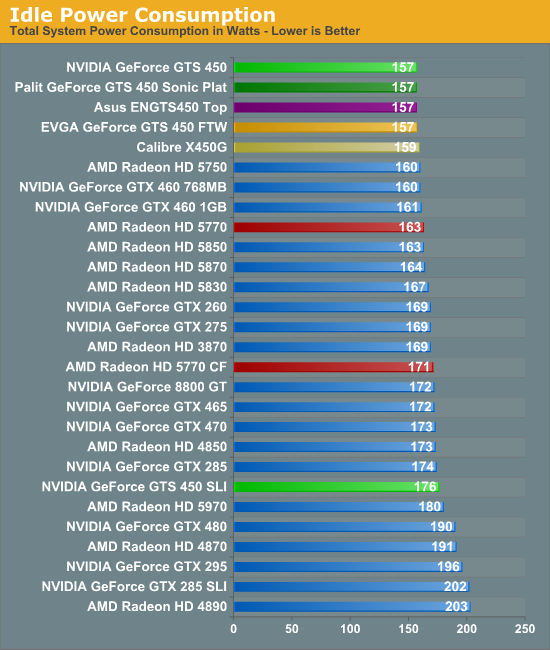
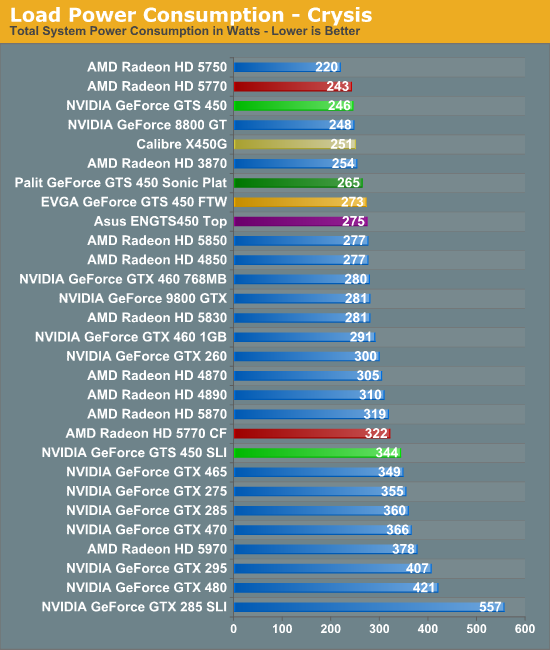
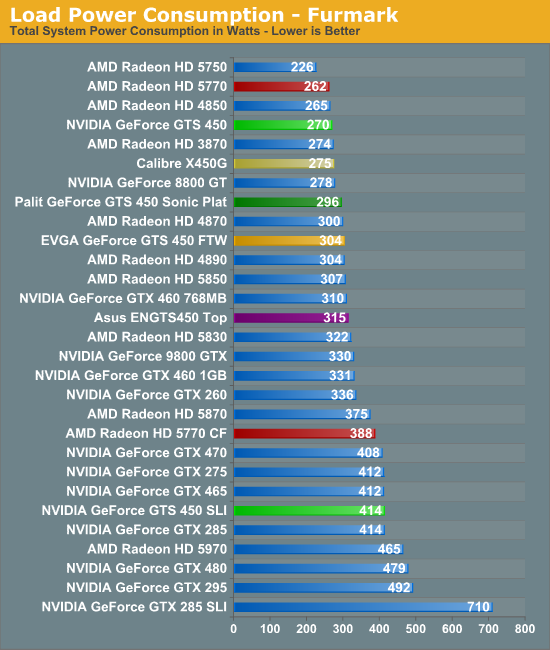
With the exception of the Calibre card –which needs to drive 2 92mm fans instead of one – all of our GTS 450 cards draw the same amount of power at idle, due to the fact that they all run at the same idle clocks and voltage. Under load the power consumption trends with the VID of the card, with the Calibre drawing the least amount of power, followed by the Palit, the EVGA, and finally the Asus card. The Asus card has the unfortunate distinction of drawing even more power than a GTX 460 768MB under Furmark, which is the penalty to be paid for an overclocked/overvolted card.

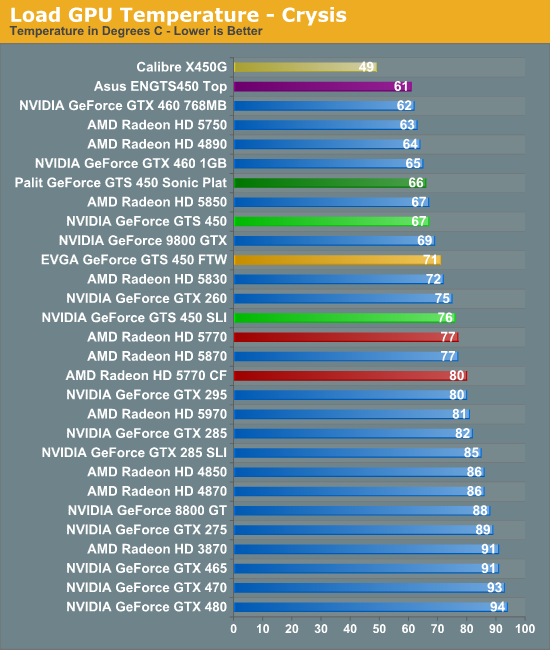
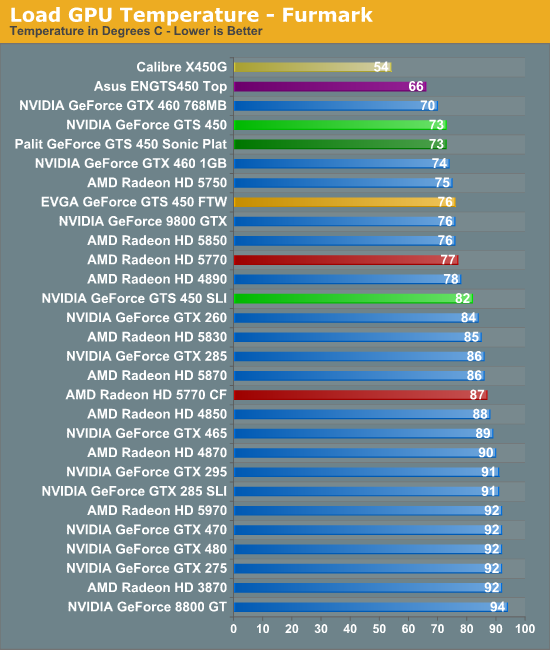
At idle, all of our cards hit roughly the same temperatures. The Calibre doesn’t get a chance to do much better here as 30C is already approaching room temperature. Meanwhile the Palit does slightly worse, perhaps as a result of it recycling more hot air in to the case.
At load however this is where we see the various cards shine. Toping our charts is the Calibre card with its massive cooler – it’s 12C cooler than the next coolest card under both Furmark and Crysis. In fact at 54C under Furmark it’s basically only lukewarm for a video card. As we said before the Twin Turbo Pro is entirely absurd for a card that only has a TDP a bit over 100W in the first place, but the results are hard to argue with.
Following the Calibre we have the rest of our cards with more traditional coolers. The Asus places second-best here and several degrees below a reference GTS 450, an unsurprising outcome given their more aggressive cooling policies. This is followed by the Palit card which manages to tie the reference GTS 450 in spite of its overclock, and finally the EVGA card which uses the same cooler as the reference card and gets a bit warmer as a result of the overclock. Even the warmest GTS 450 here is still cooler than the Radeon HD 5770 however, showcasing the high quality of the coolers used.
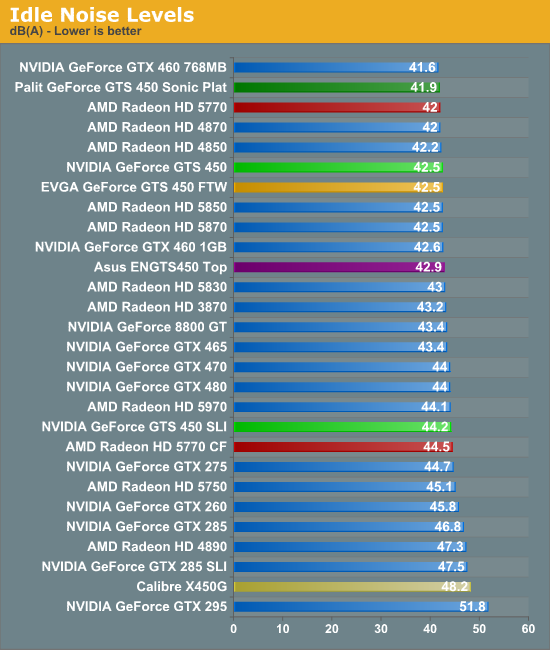
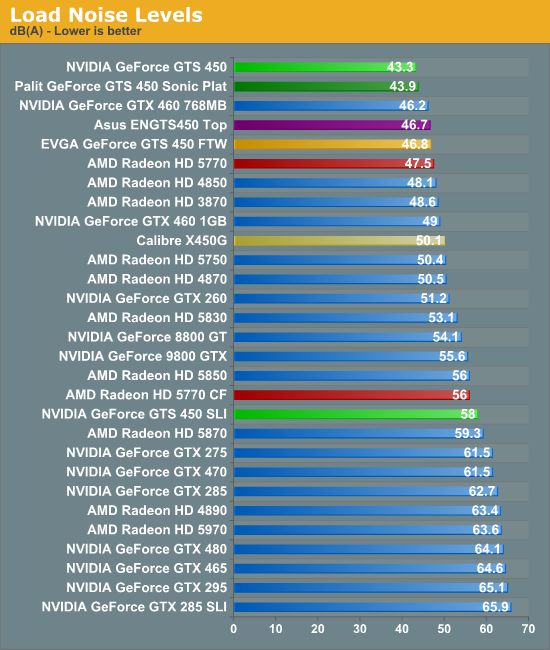
Last but not least we have noise. At idle most of our GTS 450 cards are close together as they all use similar cooler designs. The Calibre card is the lone standout, as the dual 92mm fans mean that it ends up being louder than almost all of the cards in our benchmark suite. Keep in mind that we’re talking about idle noise however, so even the “loud” X450G is still quiet enough for most cases.
Under load, noise levels are roughly where we expect them. The GTS 450 is the card to beat, and nothing can do it although the Palit card comes extremely close, made all the more impressive by its factory overclock. If this specific sample didn’t have such a low load voltage, it likely would not have done as well. Interestingly this is followed by the Asus card; Asus’s aggressive cooling usually results in louader cards, but in this case it’s still quieter than half of the cards in today’s roundup and even the 5770. This is followed by the EVGA card right on the Asus card’s heels, and finally the Calibre card pushes 50dB(A) thanks to is dual 92mm fans. This makes the card distinctly louder than the other GTS 450 cards and the 5770, but it’s still quieter than the 5750 and more than half of the other cards in our benchmark suite. It’s certainly not whisper quiet, but it should be tolerable for a card with this level of performance.










16 Comments
View All Comments
gwolfman - Monday, September 13, 2010 - link
When do we get our first single slot Fermi? I'd like one to offload my PhysX. Any ideas?Slash3 - Monday, September 13, 2010 - link
Looks like an error on the first page's chart, the memory clock box for the reference card should be at a 3.6GHz data rate and not 4.6GHz, correct?anactoraaron - Monday, September 13, 2010 - link
And their responce to the bending issue is why they are just the best to work with (and buy from) for anything - including RMA's. They are first in that category (customer service) hands down. Over the course of 7 years, I have had to RMA something (at least one item) to ASUS, HIS (the worst by far), Gigabyte and EVGA. EVGA FTW!Voldenuit - Monday, September 13, 2010 - link
Warping, like all of life's problems, is just a special case of bending.Shadowmaster625 - Tuesday, September 14, 2010 - link
You guys should simulate 2-3 months of heavy dust collecting inside a PC case. Then run the furmark power consumption and heat tests. Then you might understand why people want a card like the Calibre X450G.HangFire - Thursday, September 16, 2010 - link
2-3 months does not make for heavy dust in any of my PC cases. 2-3 years would, but none run that long before getting cleaned out.The real market for the Calibre would be the silent PC crowd, who would otherwise pay extra for an Accelero (or other aftermarket GPU cooler), and would be happy to pay a smaller premium for a pre-installed cooler- and keep their warranty too.
tech6 - Tuesday, September 14, 2010 - link
Since you can get a 5770 from NewEgg for $125 (with rebate) and GTX460 for $170, I don't see why any of these cards make much sense unless they will be heavily discounted.JPForums - Tuesday, September 14, 2010 - link
<quote>Since you can get a 5770 from NewEgg for $125 (with rebate) and GTX460 for $170, I don't see why any of these cards make much sense unless they will be heavily discounted. </quote>At $130 straight up these GTS450s make plenty of sense (especially if you don't want to deal with the sometimes less than reliable rebate system). They may not be quite as good a value as a $125 HD5770, but they are still a good buy. (particularly if you require an nVidia card) Of course, a GTX460 will net you a healthy performance boost for an equally healthy price bump.
Spazweasel - Tuesday, September 14, 2010 - link
They still do. Look in the part number. If it ends in "AR" it's lifetime warranty, if it's "TR" the warrant is (I think) 2 years. The price difference is generally 10 to 20 dollars, depending upon the base price of the part.shin0bi272 - Tuesday, September 14, 2010 - link
Id rather have a gtx470 super overclock from gigabyte. yeah its twice the price but its more than twice the speed. The gigabyte 470 soc out performs a gtx480 but costs 100 bucks less. So why go out and have to buy 2 450's to get halfway decent performance when you could buy 1 470 and spend the same amount?http://www.newegg.com/Product/Product.aspx?Item=N8...